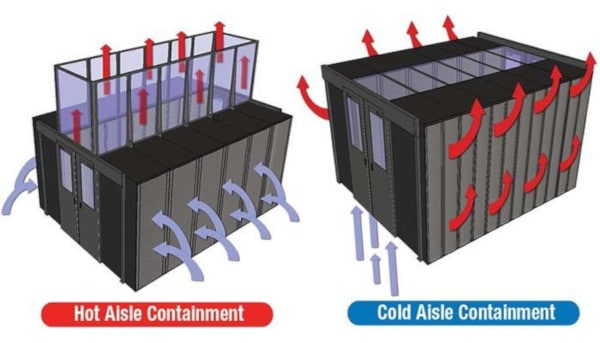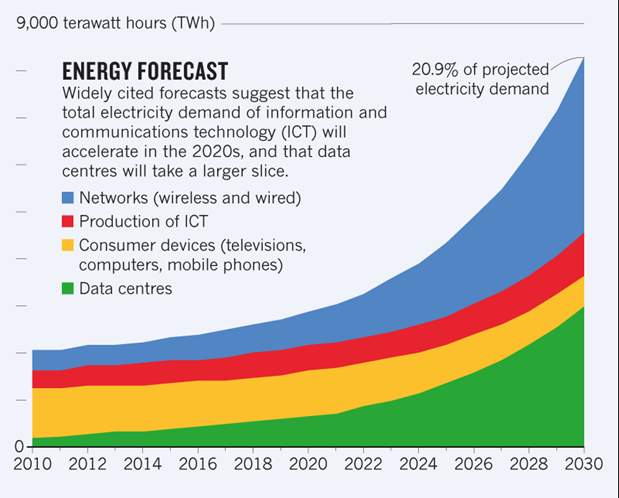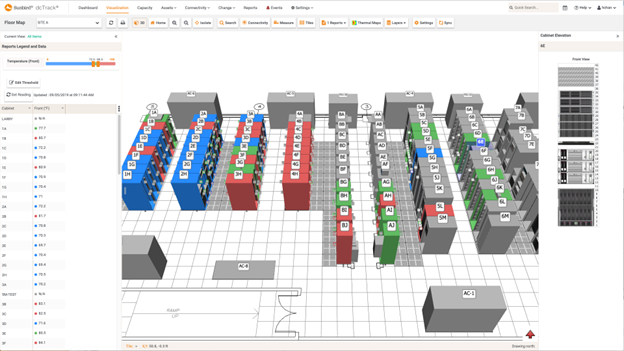Implement Hot/Cold Aisle Containment
Ceiling panels and doors enclose the hot aisle between rows of cabinets so that warm exhaust air can be separated and returned to the cooling system. Implement a data center containment strategy where cold supply air from cooling units is separated from the hot exhaust air from IT equipment.
This will enable a uniform, stable supply air temperature and warmer, drier return air. The result is that your CRAH/CRACs will only cool the hot air in the data center so they can operate at maximum efficiency.

There are a variety of containment options, including:
- Hot aisle containment. Measures how much progress has been made towards ideal environmental conditions.
- Cold aisle containment. Ceiling panels and doors enclose the cold aisle between two rows of cabinets, allowing the rest of the data center to become a hot-air return plenum.
- Chimney systems. The warm exhaust air is pushed up through chimneys above each rack to the ceiling return air plenum.
- Curtain systems. Racks are faced in alternating rows of front-to-front and back-to-back and curtains separate the cold supply air and warm exhaust air.
Global data center energy consumption is so massive, that if all the data center sites in the world were a country, they would rank as the 5th largest energy consumer.

With such large amounts of data center energy consumption, many organizations are pioneering new ways to increase energy efficiency, reduce carbon emissions, and decrease operating costs.
Data centers around the world are at the forefront of reducing their environmental impact, driving a new era of sustainability. More and more data centers deserve attention for their innovations. These data centers have some of the best Power Usage Effectiveness (PUE) metrics in the world and are proactively taking steps to mitigate any potential environmental impact.
A few examples of data centres achieving recognition include:
- LinkedIn LOR1 – Hillsboro, OR PUE: 1.06
LinkedIn’s flagship data center features rear door heat exchanges to support rack densities up to 32 kW and drive containment to the cabinet level, meaning there are no hot or cold aisles.

The facility runs on 100% renewable power and, instead of using energy to create cold air, it gets free cooling by using an advanced water side economizer that communicates with outside air sensors to leverage Oregon’s naturally cool climate.
- Microsoft Project Natick – Orkney Islands, Scotland PUE: 1.07
Project Natick is an underwater data center that can be ordered to size, rapidly deployed, and operate lights out on the sea floor to deliver high-speed cloud services to coastal cities.

With the same technique used to cool ships and submarines, raw sea water is pulled in through heat exchangers in the back of the cabinets and then returned into the ocean. The first generation of Project Natick was so successful that another data center four times larger than the original is in development.
Google acquired the Artificial Intelligence (AI) firm DeepMind in 2014 for $600 million and has since used the technology to improve its data centers’ energy efficiency, resulting in a 40% reduction in power consumption.

Every five minutes, DeepMind collects data from thousands of environmental sensors, feeds it into neural networks that predict how different combinations of potential actions will affect energy consumption, identifies the ideal actions, and sends them to the data center, where the local system verifies and implements them.
The organizations listed above have made it a top priority to maximize energy efficiency in their data centers.
Reduce Data Center Energy Consumption with Tri-Paragon’s Sunbird DCIM Software
For data center managers who wish to follow their example to save energy and reduce expenses, Sunbird’s Data Center Infrastructure Management (DCIM) software is critical for driving efficient behavior. You can’t manage what you don’t measure, and DCIM provides the monitoring and intelligence you need to be smarter about your energy usage.

The Sunbird DCIM Software measures energy usage, automatically calculates PUE to gauge the effectiveness of green initiatives, creates customer billback reports to encourage efficiency, avoids wasting energy on overcooling by showing ASHRAE compliance, and identifies power profiles for each device to easily locate and replace power hogs.
Follow our weekly blogs for additional Tips to reduce power consumption (your carbon footprint) and increase the sustainability of your data centre.
Contact Tri-Paragon Inc. for additional details including a free DEMO and pricing. We can be reached at 416 865-3392 or by email at info@triparagon.com






